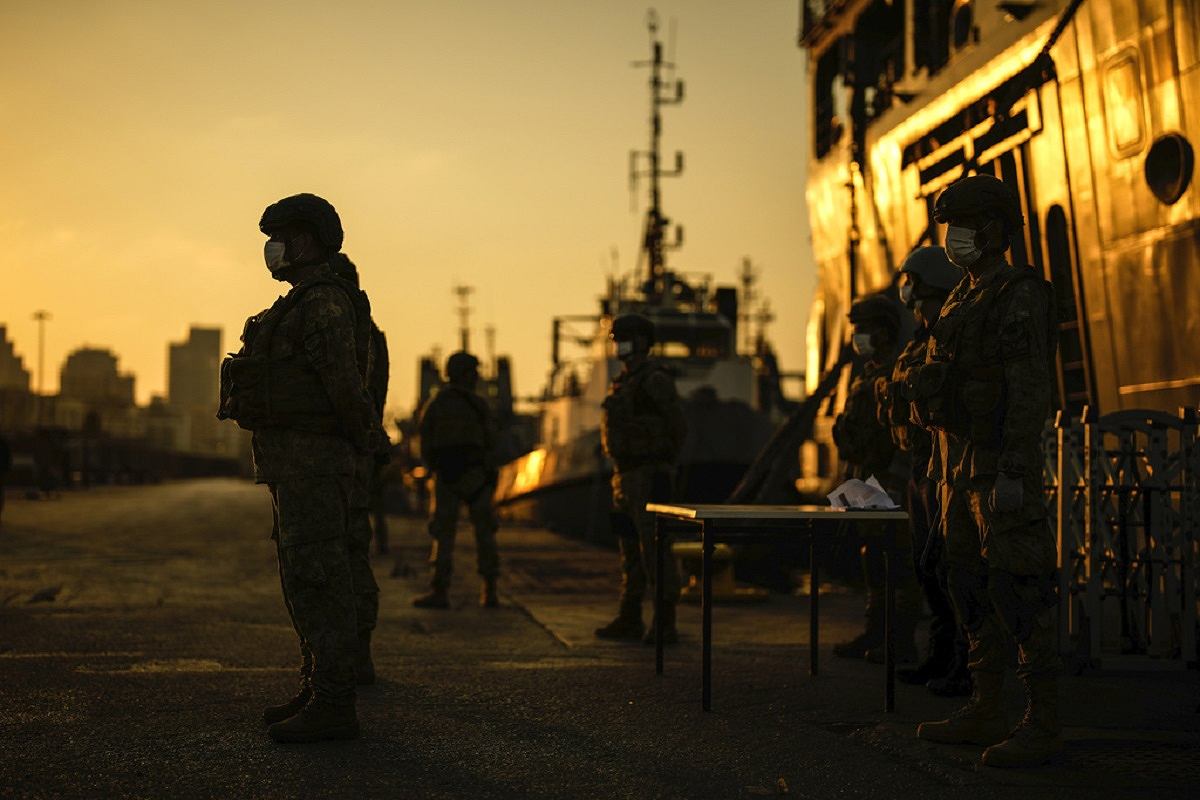
Turkish security officials stand guard next to Turkish military ships preparing to evacuate citizens from Lebanon to Turkey in Beirut port, Wednesday, Oct. 9, 2024.
11:55 JST, October 11, 2024
JERUSALEM (AP) — Israel’s ground invasion in Lebanon stretched into its second week, as the Hezbollah militant group fired hundreds of rockets deep into Israel — with no end in sight to the escalating conflict.
More than 1,400 people have been killed in Lebanon — mostly in airstrikes — and over a million displaced since the fighting intensified in mid-September. At least 15 Israeli soldiers and two civilians have been killed since the ground operation began, and more than 60,000 people have been displaced from towns along the border for more than a year.
Hezbollah began firing rockets into Israel on Oct. 8, 2023, a day after Hamas, the Palestinian militant group, attacked southern Israel, which sparked the war in Gaza. Israel and Hezbollah have exchanged fire almost every day since, coming close to a full-fledged war on several occasions but stepping back from the brink until this month.
Here’s what to know about the current ground incursion in southern Lebanon:
What is the aim of Israeli military’s ground invasion?
The Israeli military began what they called a “limited, localized and targeted ground raids” in southern Lebanon on Oct. 1. The same day, the military said that it had carried out dozens of secretive cross-border operations to destroy Hezbollah infrastructure over the past year. The aim, Israel says, is to allow its displaced residents to return home.
A military official said that thousands of Israeli troops are currently operating along the roughly 100-kilometer-long (62-mile) border, clearing the area just along the border to try to remove the launch pads where Hezbollah fires rocket-propelled grenades and anti-tank missiles into Israeli towns, as well as infrastructure they say would allow for an Oct. 7-style invasion of Israel.
The official, who spoke on condition of anonymity to discuss the military’s strategy, said the troops haven’t ventured deep inside Lebanon so far, and have conducted operations from distances of a few hundred meters (yards) up to 2 to 3 kilometers (1.5 to 2 miles) into Lebanese territory.
The Israeli military has shared videos of what it says are underground tunnels chiseled into rock used by Hezbollah. The tunnels are used to store weapons and stage attacks. One tunnel stretched from Lebanon into Israeli territory, according to the military.
The goal is not to destroy Hezbollah, and the army is aware that this will not remove the threat of longer-range rockets and missiles, the official said.
Elijah Magnier, a Brussels-based military and counterterrorism analyst, said Israeli forces haven’t seized any ground positions yet.
“They need to go in, harass, test and come out,” Magnier said. In order to hold ground positions, Israel would need tanks to come in and take high critical ground overlooking territory, he said. He estimates it would require clearing some 10 kilometers of Hezbollah presence, which is still a long way off.
It is not clear how long the operation will last or how long Israel will maintain a presence in these towns. The official said the hope is that this can lead to a diplomatic arrangement pushing Hezbollah away from the border. But the plans could change. A previous Israeli invasion of Lebanon in 1982, initially intended to push back Palestinian militants, turned into an 18-year occupation.
What is Hezbollah’s strategy?
Hezbollah officials, including assassinated leader Hassan Nasrallah, have conceded that the Israeli military has the superior air force and intelligence. But Hezbollah has the advantage in direct confrontations on Lebanese turf.
Hezbollah forces have better equipment and training compared to Hamas, which Israel has been battling for more than a year in Gaza. Hezbollah forces gained experience in wars in Syria and Iraq. Lebanon’s terrain is also more rugged and challenging than the Palestinian enclave, which is mostly flat and sandy.
Hezbollah’s strategy, led by its elite Radwan Forces, has been drawing in and ambushing incoming Israeli troops, detonating explosive devices or firing rockets at them, and firing artillery and rockets at Israeli border towns. Although Hezbollah has lost many of its top officials and commanders in recent weeks, militants have continued to fire rockets deeper into Israel, including heavy barrages on the city of Haifa.
Former Lebanese Army General Hassan Jouni said that he assessed Israel is still conducting reconnaissance ahead of its main attack, but that it had already suffered heavy losses in the smaller operations. Jouni said Hezbollah had dug many tunnels in the south and were well equipped with weapons caches and ammunition.
“The land always works in the favor of those who own it,” he said.
How does this compare to the 2006 war between Israel and Hezbollah?
Israel and Hezbollah last went to war in 2006, a 34-day conflict that ended with the United Nations Resolution 1701, which was supposed to push Hezbollah further north and keep the border region exclusively under the control of the Lebanese army and UN peacekeepers.
Israeli leaders say they want Lebanon to implement the resolution. Hezbollah says Israel hasn’t held up its part of the treaty and will stop firing rockets when there is a ceasefire in the Gaza Strip.
Israel’s searing air campaign in southern Lebanon and Beirut in recent weeks is similar to the 2006 war, though this time, better intelligence has enabled Israel to kill several of Hezbollah’s top leadership.
“The Air Force is better and is using all kinds of methods to penetrate deeper into the ground, like dropping bomb after bomb after bomb,” said Yoel Guzansky, a senior researcher at the Institute for National Security Studies in Tel Aviv. Israel killed Hezbollah leader Hassan Nasrallah in September by dropping more than 80 bombs on an apartment complex built over an underground compound in quick succession.
In the 2006 war, Israel sent ground troops into Lebanon after 10 days of airstrikes before withdrawing them about four weeks later. Troops attempted to reach the Litani River, about 30 kilometers (18.5 miles) north of the border, but suffered heavy losses before a ceasefire ended the operation and the war.
Could there be a diplomatic solution?
Hezbollah’s acting leader signaled Tuesday that the group is open to a cease-fire. Guzansky believes Israeli troops will stay on the ground in southern Lebanon until there is an internationally enforced diplomatic solution that’s stronger than the current UN peacekeeping force. If Israeli troops retreat, he said, they risk the same situation as 2006, where Hezbollah simply rearmed and resumed operations.
But former Prime Minister Ehud Olmert, who was Israel’s leader during the 2006 war, said that war served as a lesson that immediate diplomacy, rather than military force, is the only way to keep the border quiet.
“Why not try and make a deal now rather than to fight for half a year?” he asked in an interview with The Associated Press. “You lose how many soldiers, kill how many innocent people? And then in the end we’ll make a deal which may have been made in advance.”
"News Services" POPULAR ARTICLE
-

American Playwright Jeremy O. Harris Arrested in Japan on Alleged Drug Smuggling
-

Japan’s Nikkei Stock Average as JGB Yields, Yen Rise on Rate-Hike Bets
-

Japan’s Nikkei Stock Average Licks Wounds after Selloff Sparked by BOJ Hike Bets (UPDATE 1)
-

Japanese Bond Yields Zoom, Stocks Slide as Rate Hike Looms
-

Japan’s Nikkei Stock Average Buoyed by Stable Yen; SoftBank’s Slide Caps Gains (UPDATE 1)
JN ACCESS RANKING
-

Keidanren Chairman Yoshinobu Tsutsui Visits Kashiwazaki-Kariwa Nuclear Power Plant; Inspects New Emergency Safety System
-

Imports of Rare Earths from China Facing Delays, May Be Caused by Deterioration of Japan-China Relations
-

University of Tokyo Professor Discusses Japanese Economic Security in Interview Ahead of Forum
-

Japan Pulls out of Vietnam Nuclear Project, Complicating Hanoi’s Power Plans
-

Govt Aims to Expand NISA Program Lineup, Abolish Age Restriction

























